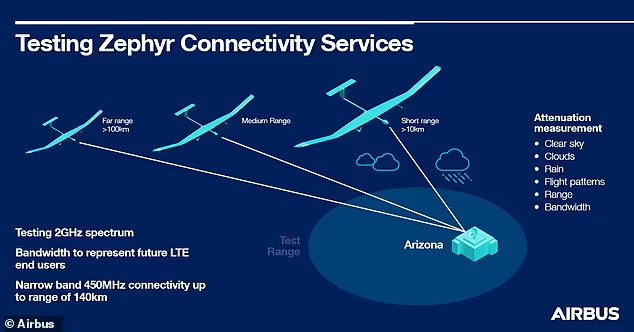Airbus recently tested the solar drone Zephyr in Arizona, usa, which flew for 18 days in the stratosphere 76,100 feet (23,195.28 meters) above the ground and successfully provided broadband Internet services to the ground.

The solar-powered drone Zepp is equipped with a "High Altitude Platform Station" (HAPS) to test the high-altitude transmission broadband service.
The test was reportedly conducted in partnership with Japanese mobile operator NTT DOCOMO. According to Airbus, ultra-high-speed broadband connectivity could one day be achieved in remote areas without the need to send a fleet of satellites into low-Earth orbit.
Airbus said the successful test could pave the way for zepp drone formations to deliver 5G and 6G mobile internet to the most remote areas on Earth, or provide short-term signal enhancement in major events in densely populated areas.
Schematic diagram of the high-altitude flight of the "Zepu" UAV.
It is reported that the "Zepu" drone is equipped with two small propellers, which are completely powered by the sun. With a wingspan of 82 feet (25 meters) and solar panels, the drone is charged in daylight to power overnight flights.
Drones are manually launched by 4 to 5 ground personnel, and onboard software can be used for remote navigation.
The Zepp drone has a wingspan of 25 meters and weighs only 75 kilograms.
The "High Altitude Platform Station" (HAPS) on the drone is made in the UK, and the teams of the two companies collect data at different times of the day and night, at different altitudes, and focus on connectivity in different weather conditions, with the aim of confirming whether the Zepp system is feasible to provide internet access to an area of about 1 million people.
An Airbus spokesperson said the tests confirmed the feasibility and versatility of the 2GHz spectrum for service on HAPS, as well as the use of narrow (450MHz) bands to provide internet connectivity over a range of up to 140 kilometers. At the same time, it is a viable solution that provides direct communication to smartphones from the stratosphere.
Takehiro Nakamura, general manager of DOCOMO's 6G-IOWN promotion department, said DOCOMO believes HAPS will be a promising solution for 5G evolution and 6G coverage expansion. Tests have shown that HAPS can fill the gap in 5G and 6G coverage, delivering next-generation mobile networks to the most remote places on Earth.
Stephane Ginoux, Airbus' head of North Asia, said the Zepp drone formation would be cheaper and easier to control than satellites, and could also land and be reused for different missions. And, because it uses sunlight to fly and recharge batteries, it doesn't use fuel and doesn't produce carbon emissions.
The drone's solar panels are charged in daylight to power overnight flights.
Jana Rosenmann, head of unmanned aerial systems at Airbus, said the Zepp drone will soon be able to stay in the air for about 6 months.
Airbus said the Zepp drone could be used in disaster areas and other areas that need real-time information. For example, it could revolutionize disaster management, including monitoring the spread of wildfires or oil spills. Or it can be a short-term solution to improve a music festival, major event, or protest.
Text/Nandu reporter Chen Lin